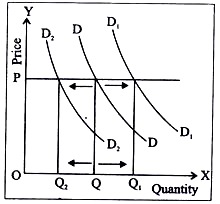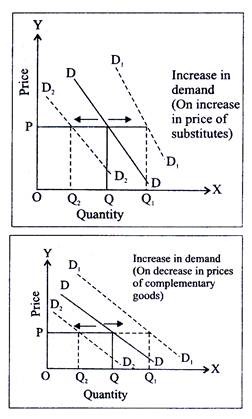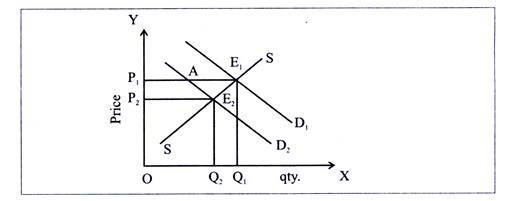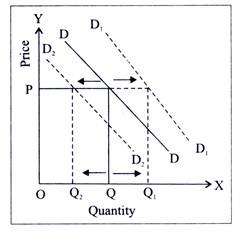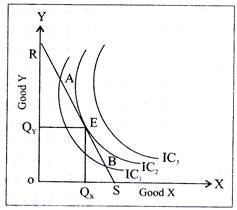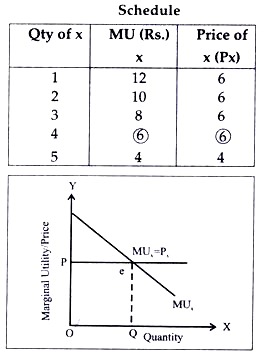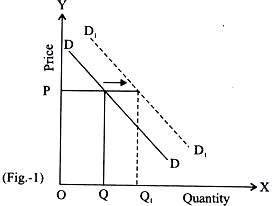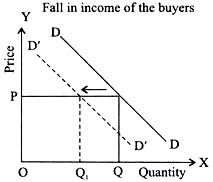Read this article to learn about the twenty six frequently asked questions on the consumer equilibrium and demand.
Q.1. Define demand. Explain the factors affecting demand of a commodity.
Ans. Demands the quantity of a commodity that a consumer is willing to buy at a particular price in a given period of time.
The factor affecting demand are:
ADVERTISEMENTS:
(i) Price of the Commodity:
A rise in the price of a commodity reduces its demand and a reduction in its price increases the demand. Thus, demand is more at a lower price and less at a higher price.
The factors affecting demand are:
(i) Price of the Commodity:
ADVERTISEMENTS:
A rise in the price of a commodity reduces its demand and a reduction in its price increases the demand. Thus, demand is more at a lower price and less at a higher price.
(ii) Income of the Consumer:
In case of normal goods, demand increases with rise in the income of the consumer and falls when the income decreases. There are however certain goods whose demand falls with the rise in income of the consumer; such goods are known as “inferior” (less expensive) goods.
(iii) Price of Related goods:
ADVERTISEMENTS:
Related goods are of two types:
(i) Substitute goods and
(ii) Complementary goods.
(a) Substitute Goods:
Goods which can be used in place of each other are called substitute goods, for example tea and coffee. A fall in the price of substitute goods will reduce the demand of the commodity as people will start buying the substitutes whose price has gone down in place of the given commodity. Similarly, in case of increase in the price of substitute goods, the demand for the commodity will increase. Thus the demand of a commodity is directly related to the price of the substitutes.
(b) Complementary Goods:
Goods which are used together to satisfy a given want, are called complementary goods. For example, car and petrol. Demand of a commodity is inversely related to the price of complementary goods. The demand for a commodity will increase if price of its complementary good falls and it will decrease if price of complementary good increases.
For example, increase in the price of petrol will reduce the demand for cars and a reduction in price of petrol will increase the demand for cars.
(iv) Tastes and Preferences:
ADVERTISEMENTS:
The demand for a commodity is also affected by the taste and preference of the consumer. The demand for a commodity will increase if consumer’s taste changes in favour of the commodity and any unfavorable change in taste or preference will reduce the demand for the commodity.
Q.2. Which factors cause decrease in demand? Explain.
Ans. A decrease in demand can be caused by following factors:
(i) Decrease in Income of the Consumer:
ADVERTISEMENTS:
In case of normal goods, demand for the commodity will decrease when there is a fall in the income of the consumer.
(ii) Decrease in price of substitute goods:
If prices of substitute goods decrease, the demand for the good whose price has not fallen will decrease.
(iii) Rise in the price of complementary goods:
ADVERTISEMENTS:
If price of complementary goods of a commodity rise, the demand for the commodity will fall.
(iv) Unfavorable Change in Tastes and Preference:
Change in consumers’ taste and preferences against the commodity would lead to a decrease in demand.
Q.3. What factors cause an increase in demand? Explain.
Ans. An increase in demand can be caused by:
(i) Increase in income of the consumer:
ADVERTISEMENTS:
In case of a normal good an increase in income causes increase in the demand of the commodity.
(ii) Increase in the price of substitute good:
An increase in the price of substitute of a commodity will increase the demand for the commodity as some consumers will leave the substitutes which have become costly now and start buying the commodity whose price has not increased.
(iii) Decrease in price of complementary goods:
The demand for a commodity will increase if price of its complementary goods go down. For example, if petrol becomes cheaper demand for cars will rise.
(iv) Favourable change in tastes and preferences:
ADVERTISEMENTS:
If the taste and preference change in favour of a commodity, its demand will increase.
Q.4. Explain the effect of the following on the demand of a good.
(i) Change in the income of the consumer.
(ii) Change in the price of the related goods.
Ans. (i) Change in the income of the consumer:
The demand of a commodity increases (rightward shift) with the increase in income of the consumer and decreases (leftward shift) when the income of the consumer falls in case of normal goods. In the above diagram, DD is the original demand curve. With the increase in income of the consumer, the demand has increased and the demand curve has shifted to D1D1 If the income of the consumer falls, the demand will also decrease and the demand curve will shift leftward to D2D2
(ii) Change in price of related goods:
Related goods can be classified into:
(a) Substitute goods and
(b) Complementary goods.
(a) Substitute Goods:
The demand of a commodity is directly related to the price of its substitutes. If prices of substitutes decrease, the demand for the commodity will also decrease (leftward shift) but if prices of substitutes increase, the demand for the commodity will increase (rightward shift) since it will become cheaper as compared to its substitutes.
ADVERTISEMENTS:
This has been shown as under:
(b) Complementary Goods:
The demand for a commodity is inversely related to the prices of its complementary goods. If prices of complementary goods fall, demand for the commodity will increase (rightward shift) e.g. a fall in price of petrol will increase the demand for cars. In case of increase in prices of complementary goods the demand of a commodity will decrease (leftward shift).
Q.5. Explain the relationship between
Ans. (i) Prices of other goods and demand for the given good.
(ii) Income of the buyers and demand for a good
(i) Other goods are of two types: Substitutes and Complements:
When price of a substitute goods falls, the given good becomes relatively dearer. As a result its demand falls.
When price of a complementary good falls (rises) the demand for the complementary goods rises (falls) and so the demand for the given goods rises (falls) because both the goods are used jointly.
(ii) When the consumer treats a good as a normal good, rise (fall) in income leads to rise (fall) in its demand.
When the consumer treats a good as an inferior good, rise (fall) in income leads to fall (rise) in its demand.
Q.6. Explain how do the following influence demand for a good:
Ans. (i) Rise in income of the consumer.
(ii) Fall in prices of the related goods.
(i) When a consumer treats a good a normal good, rise in income leads to rise in its demand.
For example, if consumer treats goods X as a normal good he is expected to demand more of X with rise in income.
When a consumer treats a good an inferior good, rise in income leads to fall in its demand.
For example, if consumer treats good Y as an inferior good, he demands less of Y with rise in income.
(ii) Fall in the price of substitute good, leads to fall in demand of the given good because the relative price of the given good rises.
For example fall in the price of coffee may lead to fall in demand for tea because relative price of tea rises.
Fall in price of the complementary good raises the demand for the given good.
For example fall in the price of petrol may lead to rise in demand for cars.
Q.7. Explain the causes of a rightward shift in demand curve of a commodity of an individual consumer.
Ans. Causes of a rightward shift in demand curve:
(i) Increase in income (Normal Good):
When income increase, buyer of the commodity can buy more at same price. This causes are rightward shift in demand curve.
(ii) Rise in Price of substitute:
When price of substitutes rises the given commodity become relatively cheaper than its substitutes it is purchased in place of its substitutes. Hence demand for commodity increase, resulting in right ward shift in demand curve.
(iii) Fall in price of complimentary good:
When price of complementary good falls, its demand rises, this will also result in increase in demand for the given good as the two are complementary.
(iv) Favourable change in taste for the good:
Favourable change in taste for good will result in more demand of it at the same price. Existing buyer of it may buy more of it.
Q.8. With the help of a diagram explain the effect of “decrease” in demand of a commodity on its equilibrium price and quantity.
Ans. i. Decrease in demand means less demand at the same price. This leads to shift of demand curve to the left from D1 to D2.
ii. Given equilibrium at E1 shift of demand curve leads to excess supply = AE1 at price OP1.
iii. This creates a situation where producers are not able to sell all they want to sell at price OP1. They start offering lower price. As a result price starts falling.
iv. As Price falls, supply begins to fall along the supply curve SS, and demand begins to rise along the demand curve D2. This continues till the new equilibrium at E2 is reached.
v. At new equilibrium, price falls to OP2 and quantity falls to OQ2
Q.9. Explain the term change in demand’ and represent the same graphically. Also state three factors responsible for change in demand.
Ans. Any increase or decrease in demand caused by factors other than price of the commodity is known as change in demand.
The change in demand can be of two types:
(i) Increase in demand and
(ii) Decrease in demand.
In case of increase in demand, the demand curve shits to the right and to the left when there is a decrease in demand as shown in the diagram below.
In the above diagram DD is the demand curve. If there is an increase in quantity demanded, the demand curve will shift from DD to D1D1. Similarly m case of decrease in demand, the demand curve will shift to the left to D2D2.
The main factors responsible for change in demand are:
(i) Change in income of the consumer.
(ii) Change in the price of substitute goods.
(iii) Change in the price of complementary goods.
(iv) Change in tastes and preferences of the consumer.
Q.10. Explain consumer’s equilibrium with the help of Indifference Curve Analysis.
Ans. A Consumer’s equilibrium is a situation when a consumer maximises his satisfaction at a given income and the given prices. Alternatively this is the condition when the consumer reaches the highest indifference curve which is within his budget constraint or limit.
Conditions for consumer’s equilibrium under IC- curve approach
1.MRSxy = PX/PY
2. MRS is diminishing
This can further be shown by diagram:
There are three IC-curves shown here, IC1, IC2 and IC3. To reach the maximum level of satisfaction the budget of the consumer has also to be kept in mind. It is the highest possible IC-curve which will be within the budget of the consumer, and will put him in a state of equilibrium.
Looking to the diagram, the combinations A or B are the points where the consumer will not be willing to stay as they are located on lower IC-curve IC1. Moreover, IC3 is actually unaffordable & unattainable as it is located beyond the budget line. IC2 is the only IC-curve which is yielding the highest satisfaction to the consumer. The budget line and IC2 are having the same slope here. Thus point E is the point of consumer’s equilibrium when the consumer is consuming OX and OY quantities of Good x and Good y respectively.
Q.11. What are Monotonic preferences? Explain why is an indifference curve (i) Downward sloping from left to right and (ii) convex.
Ans. Monotonic preferences imply that as consumption increases total utility also increases:
(i) An IC slopes downwards implies that as a consumer consumes more of one good he must consume less of the other good. It is because as he consumes more of one, his total utility increases and as he consumes less of the other his total utility decreases by the same amount. It keeps total utility unchanged along the curve.
(ii) An IC is convex because MRS is continuously falling. MRS falls because of the law of diminishing marginal utility. Let the two goods be X and Y. As he consumes more and more of X his marginal utility from X keeps on declining and therefore, the consumer is willing to sacrifice less and less of Y.
Q.12. Explain the conditions of consumer’s equilibrium with the help of the Indifference curve Analysis.
Ans. Let the two goods be X and Y. Given income, prices and preferences of the consumer, the conditions of equilibrium are
(1) MRS = Px/Py
Explanation:
If MRS > PxPy, the consumer will find it advantageous to substitute X for Y. As a result MRS will fall. This process will continue till MRS becomes equal to Px/Py (or answer based on MRS < Px/Py)
(2) MRSxy continuously falls.
In case the consumer is not in equilibrium, it is the decreasing MRS which brings back the consumer into equilibrium.
Q.13. What are the conditions of consumer’s equilibrium under the indifference curve approach? What changes will take place if the conditions are not fulfilled to reach equilibrium?
Ans. There are two conditions:
(i) MRS = Ratio of prices
(ii) MRS continuously falls
Explanation:
(1) Let the goods be X and Y. The first condition for consumer’s equilibrium is that MRS = PxPy. Now suppose, MRS is greater than Px/Py. It means that the consumer is willing to pay more for X than the price prevailing in the market. As a result the consumer buys more of X. This leads to fall in MRS. MRS continues to fall till it becomes equal to the ratio of prices and the equilibrium is established. (Or, alternatively in terms of when MRS < Px/Py)
(ii) Unless MRS continuously falls, the equilibrium cannot be established.
Q.14. Explain the conditions of consumer’s equilibrium in case of (i) single commodity and (ii) two commodities. Use utility approach.
Ans. (i) Single commodity:
The condition is MU = P.
So long as MU is greater then P, the consumer goes on buying because benefit is greater than cost. As he buys more, MU falls because of the operation of the law of diminishing marginal utility. When MU = p, consumer gets the maximum benefits and is in equilibrium.
(ii) Two commodities:
The condition (1)
(2) Law of diminishing marginal utility is operating. The ration MU/P is the per rupee MU. Suppose MU1/P1 > MU2/P2, the consumer gets more per rupee MU from commodity 1 as compared to commodity 2. As result, the consumer will divert expenditure from commodity 2 to commodity 1. This will lead to fall in MU1 and rise in MU2.
This will continue till MU1/ P1 becomes equal to MU2/ P2
Operation of the law of diminishing marginal utility is responsible for bringing the equality.
Q.15. Explain the consumer’s equilibrium in case of a single commodity with the help of a diagram and a schedule.
Ans. Consumer’s equilibrium is condition in which a consumer gets maximum satisfaction by the consumption of one or more commodities with his given income & prices. Moreover, he does not want to change his consumption pattern.
Assumptions of utility approach:
1. Utility is cardinal i.e. numerical.
2. Prices of the goods are constant.
3. Income of the consumer is fixed.
4. MU of money is constant.
Consumer’s equilibrium (Single Commodity Case)
Here the assumption is that the consumer spends whole of his income upon one good only.
Condition of consumer’s Equilibrium MUx =Px.MUM
MUx/Px– MUM, (MUM – MU of money) Schedule
i. This is clear from the schedule that the consumer will buy 4 units of x-good as the condition of MUx = Px is satisfied at 4 units of the good x. Here MUx is expressed in terms of rupees.
ii. This is clear from the diagram that the consumer will buy 4 units of the good – X. If he buys 2 units then MUx > P it will make him buy more as he is benefitted. But as MUx > Px is reached i.e. he enjoys maximum satisfaction here. He will not go beyond 4 units as Px > MUx and it will be a loss to the consumer.
Q.16. Explain the effects of rise in income on demand for a good. Use diagram.
Ans. The effect of rise in income on demand will be as under:
(i) Normal Good:
In case of normal goods, increase in income of the consumer would lead to increase in demand of the commodity and the demand curve will shift to the right as shown in figure (1).
In figure (1) DD is the original demand curve for normal good and due to rise in income the demand curve has shifted from DD to D1D1. The quantity demanded has increased from OQ to OQ1.
(ii) Inferior Good:
In case of inferior good, the rise in income will decrease the demand for the commodity and demand curve will shift to the left as shown in figure (2).
In figure (2) the original demand curve for inferior good is DD. As a result of increase in the income of the consumer the demand has decreased from OQ to OQ1 and the demand curve has shifted to the left from DD to D1D1.
Q.17. Explain the effect of rise in the prices of related goods on the demand for a good X. Use diagrams.
Ans. Related goods are of two types:
(i) Substitute goods.
(ii) Complementary goods.
The effect on demand for the good X will depend upon whether the related good whose price has risen is a substitute of X or complementary good for X.
(i) Substitute Good:
If price of substitute good has increased, demand for the good X will increase, since X will become relatively cheaper and people will replace the other good whose price has increased in comparison to that of X. In figure (A) below DD, the original demand curve has shifted from DD to D’D’ and quantity demanded has increased from OQ to QQ’ due to increase in the price of substitute.
(ii) Complementary Good:
In case of rise in the price of complementary good, demand for commodity X will decrease. In figure (B), DD is the original demand curve. Due to increase in the price of complementary good the demand curve has shifted from DD to D’D’ and quantity demand has got reduced from OQ to OQ1.
Q.18. Why do people tend to buy more at lower price? Explain why demand curve is negatively sloped?
Or
Why does demand of a commodity fall with rise in its price? Explain
Or
Describe the reasons of law of demand.
Ans. The reasons of law of demand can be put as under with explanation.
1. Income Effect:
When there is a rise in price, the real income of the consumer falls. As his purchasing power is reduced, he is compelled to buy less quantity, i.e. demand for the good falls. Whereas money income remains unchanged and vice versa.
2. Substitution Effect:
With an increase in the price of commodity, the demand for its substitutes rises which are cheaper Consequently, the demand for the communality falls, vice versa is also true in case price of commodity falls.
3. Law of Diminishing Marginal Utility:
Every rational consumer wants to follow MU = P condition while going for the purchase of a commodity. If the price of a commodity decreases then MU > P, then to remain in equilibrium, a fall in MU is required. This is only possible when more quantity would be demanded. Thus there is an inverse relation between the price and quantity demanded.
4. Creation of New consumer groups:
If the price of a commodity decreases, new consumer group may appear. This is due to the increased affordability for the commodity thus, the demand rises not only due to fall in price but also due to the arrival of first time users of that commodity.
Q.19. State and explain the characteristics of indifference curves.
Or
Explain the three properties of indifference curves.
Ans. (1) Slopes downward from left to right:
To consume more of one good the consumer must give up some quantity of the other good so that total utility remains the same.
(2) Convex towards the origin:
MRS declines continuously due to the operation of the law of diminishing marginal utility.
(3) Higher indifference curves represents higher utility:
Higher IC represents large bundle of goods. Which means more utility because of monotonic preference.
Q.20. Explain the concept of Marginal Rate of Substitution (MRS) by giving an example. What happens to MRS when consumer moves downwards along the indifference curve? Give reasons for your answer.
Ans. MRS is the ratio of the units of one good sacrificed and the units of the other good obtained. Let the two goods be X and Y, given a certain consumption of X and Y, suppose consumer wants one more unit of X. Having one more unit of X reduces marginal utility of X therefore the consumer is willing to sacrifice less units of Y. As he goes on obtaining more and more of X, marginal utility of X goes on falling and thus consumer is willing to sacrifice less and less of Y.
Q.21. Explain any three factors on which price elasticity of demand for a commodity depends.
Ans. Price elasticity of demand for a commodity depends on the following factors:
(i) Availability of Substitute:
a. Demand of a commodity having close substitutes tends to be elastic.
b. On increase in price of such commodity, people will shift to its close substitutes which causes a decline in the demand for the commodity.
c. On the contrary, goods which don’t have substitutes will have an inelastic demand.
(ii) Nature of Commodity:
i. The nature of the commodity i.e. whether it is a necessity or a luxury will also influence its price elasticity and demand.
ii. Demand for necessary goods is inelastic whereas that for luxuries is elastic.
(iii) Number of Uses:
If a commodity has a number of uses (e.g., Milk), its demand will be more elastic as compared to a good having single use only. Goods having less uses their demand will be inelastic (e.g., Toothpaste).
Q.22. Define market demand. State factors affecting it.
Ans. Market demand is the sum total of individual demands of all consumers at different prices in a given period of time.
The factors affecting market demand for a commodity are:
(i) Price of the Commodity:
Market demand will rise when the price of the commodity falls and it will fall with the rise in the price of the commodity.
(ii) Income of the Consumers:
Market demand of normal goods is directly related to the income of the consumers. It will increase when the incomes of the consumers increase and decrease when there is a fall in their income.
(iii) Price of Related goods:
Like individual demand, the market demand of a commodity will also be affected by changes in prices of substitutes and complementary goods of the commodity. Increase in prices of substitutes will increase its market demand and fall in they prices will decrease its market demand. Similarly, market demand of a good will increase when prices of its complementary goods fall and when they increase, its market demand will fall.
(iv) Tastes and Preferences:
A favourable change in consumers’ tastes and preference will increase the market demand and it will decrease if change in tastes and preferences is against the commodity.
(v) Number of Consumers in the market:
If the population is large, number of consumers will be large and thus market demand will be more. Market demand thus depends upon the number of consumers in the market.
(vi) Distribution of income:
If the distribution of income in the country is even, market demand will be more for a commodity. If distribution of income is uneven, market demand for the commodities will be at lower level. Thus distribution of income also affects the market demand.
(vii) Age and Sex Composition of Population:
The age group and sex composition also affect the market demand. For example, in a country with large population of children, demand for commodities meant for children will be more.
Q.23. Explain with the help of a diagram, the effect of the following changes on the demand of a commodity:
(i) Fall in the price of substitute good.
(ii) Fall in the income of the buyers.
Ans. (i) Fall in the price of Substitute Goods:
In case of fall in the price of substitute goods, the demand for the commodity will decrease (leftward shift) as people will start preferring the substitutes that have become cheaper now. In Figure-1, DD is the original demand curve. With fall in prices of substitutes, demand curve has shifted to D’D’ and quantity demanded has decreased from OQ to OQ1
(ii) Fall in income of the buyers:
Fall in income of the consumer would also decrease the demand (leftward shift) for the normal commodity. The demand curve will shift towards left and quantity demanded will be reduced as shown in Figure-2. The original demand curve DD has shifted to D’D’ and quantity demanded has decreased by QQ1 when buyer’s income falls.
Q.24. Explain the difference between (i) inferior goods and normal goods and (ii) cardinal utility and ordinal utility. Give example in each case.
Ans. (i) Any good whose demand falls with rise in income is called an inferior good.
Example:
Suppose with rise in income a consumer buys less of X and instead buys more of Y then good X is inferior for that consumer Normal good is one whose demand rises with rise in income. Suppose with rise in income consumer buys more of X, then X is a normal good for that consumer.
(ii) When utility can be expressed in exact units it is called Cardinal
Utility:
Suppose a consumer says that he gets 2 units of utility from consumption of a good, then it is Cardinal Utility. When utility is expressed in ranks, it is called Ordinal Utility. When a consumer says he gets less satisfaction from second unit as compared to the first unit, it is expression in terms of ordinal utility.
Q.25. Explain the concepts of (i) marginal rate of substitution and (ii) budget line equation with the help of numerical examples.
Ans. (i) MRS:
The rate at which the consumers willing to sacrifice quantity of one good to obtain one more unit of the other good.
Example:
Suppose the consumer has IX + 6Y.
He wants one more unit of X. For this he is willing to sacrifice 3Y. Then,
MRS= ∆Y/∆X= 3/1=3
(ii) Budget line equation: Px X + Py . Y = m
Where Px is price of good X, X is quantity consumed of X; Py is price of good Y and Y is quantity consumed of Y; m is income.
Let Px = 2, Py = 1, and m = 10, then the equation becomes: 2.X + 1.Y = 10
Q.26. Explain with the help of diagrams, the effect of the following changes on the demand of a commodity.
(i) A fall in the price of complementary goods.
(ii) A rise in income of its buyer.
Ans. (i) A Fall in the price of complementary goods:
i. A fall in the price of complementary goods will increase the demand (rightward shift) for that commodity.
ii. For example, a fall in the price of petrol will increase the demand for cars. In the diagram A below, DD, the original demand curve, has shifted towards right to D’D’ with the fall in price of complementary good and the demand for the commodity has increased from OQ to OQ1.
(ii) Effect of rise in income of the consumer:
i. The demand for a normal good will increase (rightward shift) with the rise in income of the consumer, but in case of inferior commodity, the increase in income would lead to a decrease in demand (leftward shift).
ii. In the diagram, DD was the original demand curve, has shifted towards right to D1D1 and demand has increased from OQ to OQ1 for a normal good.
